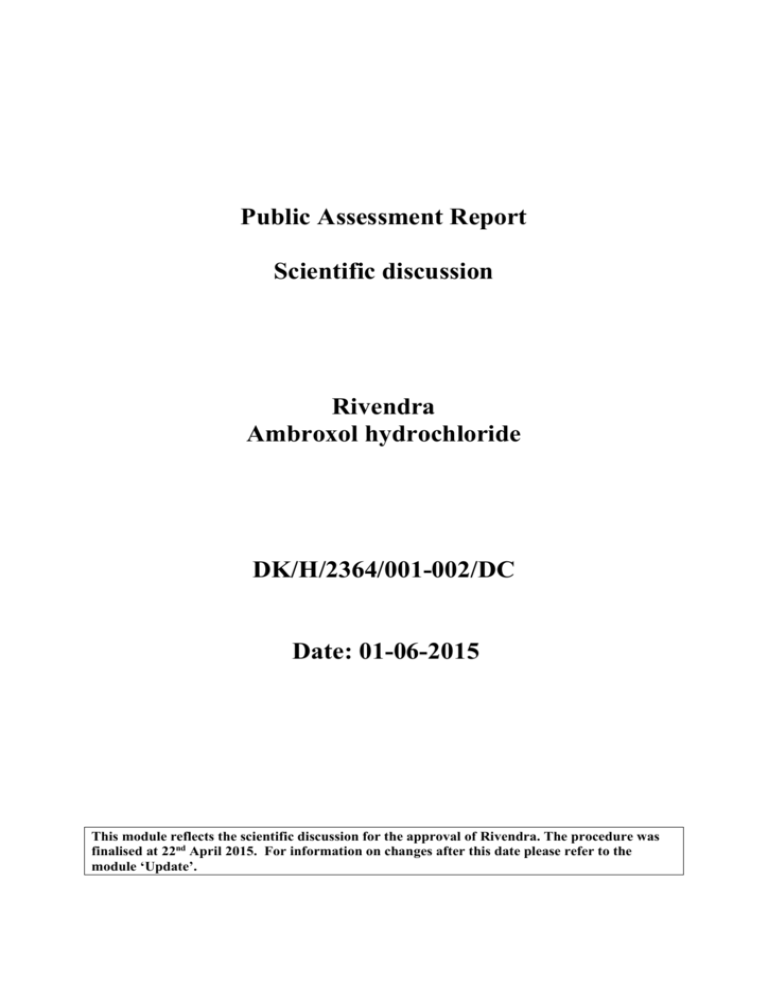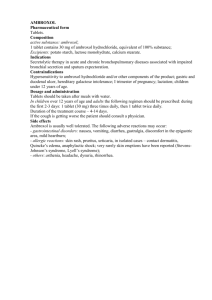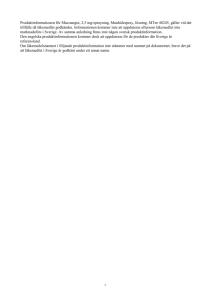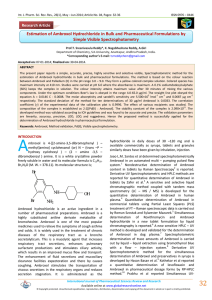Version 10 February 2012
advertisement

Public Assessment Report Scientific discussion Rivendra Ambroxol hydrochloride DK/H/2364/001-002/DC Date: 01-06-2015 This module reflects the scientific discussion for the approval of Rivendra. The procedure was finalised at 22nd April 2015. For information on changes after this date please refer to the module ‘Update’. I. INTRODUCTION Based on the review of the quality, safety and efficacy data, the Member States have granted marketing authorisations for Rivendra 3 mg/ml and 6 mg/ml oral solution, from Actavis Group PTC ehf. The products are indicated for mucolytic therapy of productive cough in acute or chronic bronchopulmonary diseases associated with abnormal mucus secretion and impaired mucus transport. A comprehensive description of the indication and posology is given in the SmPC. Ambroxol, an active metabolite of bromhexine, is a mucoactive agent that possesses manifested secretolytic effect, regulates the production of mucus and normalizes its viscosity by intracellular activation at formation of serous secretion and reduction of sulfomucine synthesis in cells. The marketing authorisation has been granted pursuant to Article 10(1) of Directive 2001/83/EC., a so-called generic application. The reference products are Mucosolvan 3 mg/mL, syrup and Mucosolvan Kindersaft 6 mg/mL marketed by Boehringer Ingelheim. No bioequivalence studies have been conducted to compare the bioavailability of the reference and the Actavis products Agreement between Member States was reached during a written procedure. There was no discussion in the CMDh. II. II.1 QUALITY ASPECTS Introduction Each ml of oral solution contains 3 mg or 6 mg of ambroxol hydrochloride. The oral solution is colourless or pale yellow with strawberry flavor. The oral solution is provided in amber glass bottle with child proof cap (HDPE), outer cap (PP) and an adaptor (PE). An oral syringe 5 ml (PP) with plunger (HDPE) is included in the package. Approved pack sizes are 100 ml and 200 ml of oral solution. The excipients are: Sodium benzoate (E211) Sorbitol (Е420) Sucralose Hydroxyethylcellulose Citric acid monohydrate Purified water Strawberry flavour (501440 T): Propylene glycol (E1520) Flavouring substances PAR Scientific discussion 2/8 Compliance with Good Manufacturing Practice (GMP) The RMS has been assured that acceptable standards of GMP (see Directive 2003/94/EC) are in place for this product type at all sites responsible for the manufacturing of the active substance as well as for the manufacturing and assembly of this product prior to granting its national authorisation. II.2 Drug Substance The product contains the active substance ambroxol hydrochlororide which is sourced from one manufacturer. The manufacturer of ambroxol hydrochloride holds a valid Certificate of Suitability (CEP) which verifies that the active substance is suitably controlled by the monograph if supplemented by additional tests for residual solvents as specified in the CEP. INN: Chemical name: Molecular formula: Molecular mass: Structural formula: Ambroxol hydrochloride trans-4-[(2-Amino-3,5-dibromobenzyl)amino]cyclohexanol hydrochloride C13H19Br2ClN2O 414.6 g/mol Ambroxol hydrochloride is described in the European pharmacopoeia (Ph. Eur.). It is a white or yellowish crystalline powder. It is soluble in methanol, sparingly soluble in water and practically insoluble in methylene chloride. All relevant aspects of the manufacturing process have been evaluated by the European Directorate for the Quality of Medicines (EDQM) prior to granting the CEP. The finished product manufacturer employs the analytical methods described in Ph. Eur. II.3 Medicinal Product The drug product is an oral solution with strawberry flavor in strengths 3 mg/mL and 6 mg/mL packaged in dark glass bottles (type III) with a child proof cap (HDPE), outer cap (PP) and an adaptor (PP). The drug product is also packaged with an oral syringe. The development of the drug product has been suitably described, the choice of excipients is justified and their functions explained. The manufacturing process can be characterised as a standard process. The process has been sufficiently detailed with respect to the manufacturing parameters e.g. homogenisation time, temperature of heating, dissolution and cooling. The product specifications cover appropriate parameters for this dosage form. Validation data of the analytical methods have been presented to support the suitability of the methods. Batch analysis has been performed on 3 batches of strength 3 mg/mL and 6 mg/mL. The batch analysis results of both strengths show that the finished products meet the specifications proposed and that a consistent drug product is obtainable. PAR Scientific discussion 3/8 The conditions used in the stability studies are according to the ICH stability guideline. For both strengths the stability data support a shelf-life/storage condition of 2 years with no special storage conditions. Approved shelf-life after first opening is 6 months. III. NON-CLINICAL ASPECTS Pharmacodynamic, pharmacokinetic and toxicological properties of ambroxol are well known. As ambroxol is a widely used, well-known active substance, the applicant has not provided additional studies and further studies are not required. Overview based on literature review is, thus, appropriate. The provided non-clinical overview on the pre-clinical pharmacology, pharmacokinetics and toxicology is adequate. III.1 Ecotoxicity/environmental risk assessment (ERA) Since Rivendra is intended for generic substitution, this will not lead to an increased exposure to the environment. An environmental risk assessment is therefore not deemed necessary. IV. CLINICAL ASPECTS The reference products are Mucosolvan 3 mg/mL, syrup and Mucosolvan Kindersaft 6 mg/mL marketed by Boehringer Ingelheim. No bioequivalence studies have been conducted to compare the bioavailability of the reference and the Actavis products. A waiver for not conducting a bioequivalence study is claimed for both strengths referring to the dosage form i.e. an aqueous oral solution at the time of administration and the concentrations of the active substance being identical to that of the reference products. Compositional differences between the Actavis products and the corresponding brand leader products have been observed. These differences have been adequately justified from a biowaiver point of view. IV.1 Risk Management Plan The Marketing authorisation holder has submitted a risk management plan, in accordance with the requirements of Directive 2001/83/EC as amended, describing the pharmacovigilance activities and interventions designed to identify, characterise, prevent or minimise risks relating to Rivendra. Summary of safety concerns Important identified risks Important potential risks Missing information PAR Scientific discussion - Accumulation of ambroxol metabolites (produced in the liver) in patients with severe renal impairment and in patients with hepatic impairment - Anaphylactic reactions including anaphylactic shock Allergic reactions including severe skin reactions (SCARS) - Use during pregnancy - Use during lactation - Use in children 4/8 Safety concern Routine risk minimisation measures Accumulation of ambroxol metabolites (produced in the liver) in patients with severe renal impairment and in patients with hepatic impairment (Proposed) text in SmPC Additional risk minimisation measures None proposed A warning is included in section 4.2 d regarding the use of ambroxol in patients with renal impairment or hepatic impairment. A warning is included in section 4.4 describing that accumulation of the metabolites of ambroxol generated in the liver can be expected in the presence of severe renal impairment. Caution is advised in patients with renal or hepatic impairment. (Proposed) text in PIL Anaphylactic reactions including anaphylactic shock A warning is included in section 2 advising the patient to talk to a doctor or pharmacist before taking ambroxol if the patient has or has had liver or kidney problems. (Proposed) text in SmPC None proposed Anaphylactic reactions including anaphylactic shock is listed in section 4.8. (Proposed) text in PIL Allergic reactions includeing severe skin reactions (SCARS) Severe allergic reactions including shock are listed in section 4. Proposed text in SmPC: In section 4.4 it is mentioned that very rarely, the occurrence of severe skin reactions such as Stevens-Johnson syndrome and Lyell’s syndrome coinciding with the use of ambroxol has been reported. If new skin and mucousmembrane changes occur, the advice of a doctor should therefore be sought without delay and the use of ambroxol discontinued. None proposed Proposed text in PIL: PAR Scientific discussion 5/8 Safety concern Use in pregnancy Use in lactation Use in children Routine risk minimisation measures Additional risk minimisation measures A warning is included in section 2 advising patients to contact a doctor immediately and stop taking ambroxol if lesions and blistering appear on the skin or on mucous membranes. (Proposed) text in SmPC None proposed A warning is included in Section 4.6 describing that in animal studies ambroxol have not shown any harmful effects. Extensive clinical experience after the 28th week of pregnancy has shown no evidence of harmful effects on the foetus. Nonetheless, the usual precautions regarding the use of drugs during pregnancy should be observed. Especially during the first trimester, the use of ambroxol is not recommended. (Proposed) text in PIL A warning is included in section 2 describing that pregnant women or women planning to become pregnant should seek advice from a doctor or pharmacist before taking this medicine. (Proposed) text in SmPC None proposed A warning is included in section 4.6 describing that ambroxol is excreted into breast milk and the use of ambroxol is not recommended in nursing mothers. (Proposed) text in PIL A warning is included in section 2 describing that ambroxol is excreted into breast milk and the use of ambroxol is not recommended in nursing mothers. (Proposed) text in SmPC None proposed In section 4.2 of the SmPCs for ambroxol syrup, dosing recommendations are given for children from 6 to 12 years and children from 2 to 6 years. In the SmPC for ambroxol effervescent tablets, dosing recommendations are given for children from 6 to 12 years of age and for the 60 mg strength dosing recommendations are given for adolescents from 12 years of age. PAR Scientific discussion 6/8 Safety concern Routine risk minimisation measures Additional risk minimisation measures In section 4.3 ambroxol syrup is contraindicated for use in children, ambroxol effervescent tablets 30 mg are contraindicated for children below 6 years of age and ambroxol effervescent tablet 60 mg are contraindicated in children below 12 years of age. (Proposed) text in PIL A contraindication is included in section 2 for both ambroxol syrup and effervescent tablets, stating that ambroxol should not be used in children. The age groups where they are contraindicated below depend on the product and strength of the products. V. USER CONSULTATION The package leaflet has been evaluated via a user consultation study in accordance with the requirements of Articles 59(3) and 61(1) of Directive 2001/83/EC. The language used for the purpose of user testing the PIL was English. The results show that the package leaflet meets the criteria for readability as set out in the Guideline on the readability of the label and package leaflet of medicinal products for human use. The test consisted of a pilot test with 3 participants, followed by two rounds with 10 participants each. The questions covered the areas traceability, comprehensibility and applicability sufficiently. VI. OVERALL CONCLUSION, BENEFIT/RISK ASSESSMENT AND RECOMMENDATION Rivendra 3 mg/ml and 6 mg/ml oral solution have a proven chemical-pharmaceutical quality and are generic forms of Mucosolvan 3 mg/mL syrup and Mucosolvan Kindersaft 6 mg/mL. Ambroxol hydrochloride is a well-known active substance with an established favourable efficacy and safety profile. An adequately justified waiver for not conducting a bioequivalence study has been presented. The marketing authorisation holder has provided written confirmation that systems and services are in place to ensure compliance with their pharmacovigilance obligations. The SmPC, package leaflet and labelling are in the agreed templates and are in agreement with other ambroxol containing products. PAR Scientific discussion 7/8 Agreement between Member States was reached during a written procedure. There was no discussion in the CMD(h). The Concerned Member States, on the basis of the data submitted, considered that essential similarity has been demonstrated for Rivendra with the reference product, and have therefore granted a marketing authorisation. The decentralised procedure was finalised on 22nd April 2015. PAR Scientific discussion 8/8




